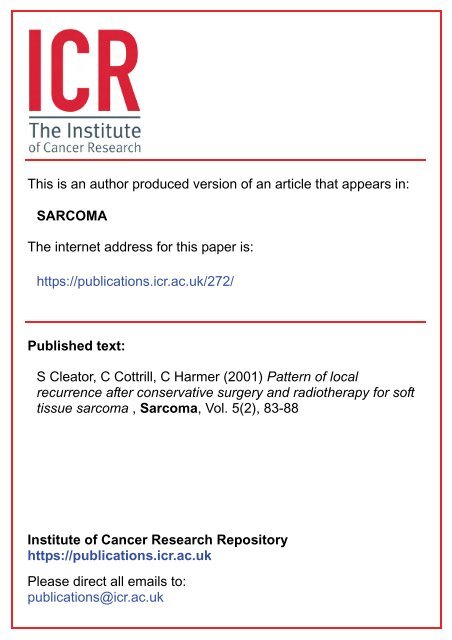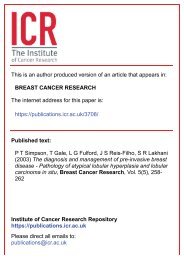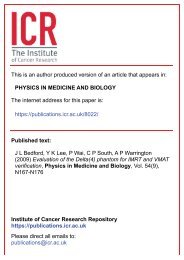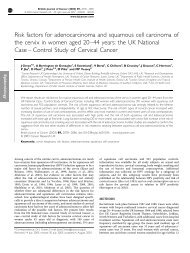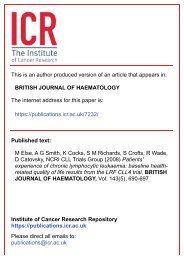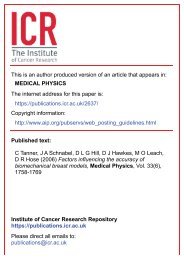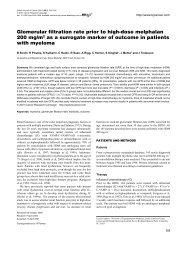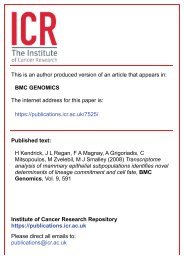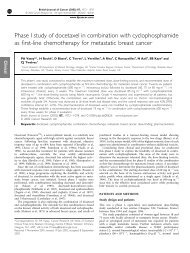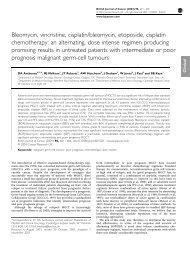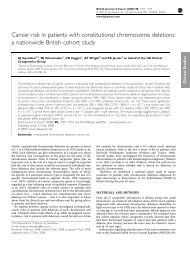Pattern of local recurrence after conservative surgery and ...
Pattern of local recurrence after conservative surgery and ...
Pattern of local recurrence after conservative surgery and ...
You also want an ePaper? Increase the reach of your titles
YUMPU automatically turns print PDFs into web optimized ePapers that Google loves.
This is an author produced version <strong>of</strong> an article that appears in:SARCOMAThe internet address for this paper is:https://publications.icr.ac.uk/272/Published text:S Cleator, C Cottrill, C Harmer (2001) <strong>Pattern</strong> <strong>of</strong> <strong>local</strong><strong>recurrence</strong> <strong>after</strong> <strong>conservative</strong> <strong>surgery</strong> <strong>and</strong> radiotherapy for s<strong>of</strong>ttissue sarcoma , Sarcoma, Vol. 5(2), 83-88Institute <strong>of</strong> Cancer Research Repositoryhttps://publications.icr.ac.ukPlease direct all emails to:publications@icr.ac.uk
Sarcoma (2001) 5, 83–88ORIGINAL ARTICLE<strong>Pattern</strong> <strong>of</strong> <strong>local</strong> <strong>recurrence</strong> <strong>after</strong> <strong>conservative</strong> <strong>surgery</strong> <strong>and</strong> radiotherapyfor s<strong>of</strong>t tissue sarcomaSUSAN J. CLEATOR 1 , CHRIS COTTRILL 2 & CLIVE HARMER 11 Sarcoma Unit, Royal Marsden Hospital NHS Trust, London SW3 6JJ, <strong>and</strong> 2 St Bartholomew’s Hospital, London EC1A7BE, UKAbstractPurpose: Over the past three decades our centre has adopted a policy <strong>of</strong> <strong>conservative</strong> <strong>surgery</strong> followed by adjuvant radicaldoseradiotherapy for medium- <strong>and</strong> high-grade s<strong>of</strong>t tissue sarcomas. For all cases <strong>of</strong> <strong>local</strong> <strong>recurrence</strong> following this treatmentwe aimed to define the spatial relationship between sites <strong>of</strong> <strong>recurrence</strong> <strong>and</strong> the positions <strong>of</strong> the phase 1 <strong>and</strong> 2 radiotherapyvolumes.Patients: We identified 25 cases <strong>of</strong> <strong>local</strong> <strong>recurrence</strong> recorded on our s<strong>of</strong>t tissue sarcoma database between 1986 <strong>and</strong> 1999inclusive. We excluded patients with macroscopic residual disease following <strong>surgery</strong>. Most patients were treated with a phaseI volume corresponding to the entire muscle compartment (50 Gy in 25 fractions over 5 weeks) <strong>and</strong> a phase II volume correspondingto the tumour bed (10 Gy in five fractions). Six <strong>of</strong> the patients were treated according to a hyperfractionatedregimen.Methods: For each case we reviewed the diagnostic imaging, planning radiographs <strong>and</strong> prescription sheets. We auditedwhether treatment had been given according to protocol <strong>and</strong> defined whether <strong>recurrence</strong> had arisen in the phase 1 volume,phase 2 volume or ‘out <strong>of</strong> field’.Results: Four (16%) patients recurred within the phase I volume, 17 (68%) recurred within the phase II volume <strong>and</strong> four(16%) outside the irradiated volume including one marginal <strong>recurrence</strong>. In six patients there had been deviation from ourradiotherapy protocol (usually unavoidable) including all three true out <strong>of</strong> field <strong>recurrence</strong>s.Discussion: The majority <strong>of</strong> <strong>recurrence</strong>s occur in the phase 2 volume. Prospective multi-centre data collection <strong>and</strong>, ideally,a prospective r<strong>and</strong>omised trial are required to formulate an improved treatment policy with respect to radiotherapy margins<strong>and</strong> dose.Key words: sarcoma, post-operative radiotherapy, <strong>recurrence</strong>, <strong>conservative</strong> <strong>surgery</strong>IntroductionThe recommended treatment <strong>of</strong> resectable high-grades<strong>of</strong>t tissue sarcoma is <strong>conservative</strong>, organ-preserving<strong>surgery</strong> followed by adjuvant radical radiotherapy.Combined modality treatment <strong>of</strong> this nature canachieve 5-year <strong>local</strong> control rates <strong>of</strong> 85–90% 1–7 <strong>and</strong> 5-year overall survival rates in excess <strong>of</strong> 70%. 1–3,5,7,8 Interms <strong>of</strong> <strong>local</strong> control <strong>and</strong> survival this comparesfavourably with the results achieved by radical <strong>surgery</strong>or amputation. 5,9,10 In addition to a <strong>local</strong> failure rate<strong>of</strong> up to 20% at 5 years, <strong>local</strong> <strong>recurrence</strong>s later thanthis have been documented. 2 Approximately 60% <strong>of</strong><strong>recurrence</strong>s are salvageable with further <strong>surgery</strong> butthis may involve amputation. 2–4In delivering postoperative radiotherapy we aim toimprove functional outcome by reducing the extent<strong>of</strong> surgical resection required to achieve cure.However, radiotherapy morbidity can also impact onfunction <strong>and</strong> there is evidence that the risk <strong>of</strong>complications increases with both dose 7,8,11 <strong>and</strong> fieldsize. 11 Between sarcoma units practice variesconsiderably with respect to the size <strong>of</strong> radiationportal employed relative to the tumour bed; somecentres, including ours, irradiate the entire muscularcompartment whilst others utilise a much smallervolume, treating the tumour bed with a margin <strong>of</strong> afew centimetres only by means <strong>of</strong> brachytherapy. 12Over the last two decades our unit has adopted atreatment policy <strong>of</strong> <strong>conservative</strong> <strong>surgery</strong> <strong>and</strong> adjuvantradiotherapy for all high <strong>and</strong> medium-grade tumours.The majority <strong>of</strong> patients are treated in accordancewith a strict radiotherapy protocol. 13 Our sarcomadatabase was used to identify 25 cases <strong>of</strong> <strong>local</strong> <strong>recurrence</strong>dating back to 1986. Disease <strong>and</strong> treatmentdetails relating to each case were analysed to identifythe exact spatial relationship between site <strong>of</strong> <strong>recurrence</strong><strong>and</strong> the irradiated volume.Correspondence to: Dr Susan Cleator, Department <strong>of</strong> Radiotherapy, Royal Marsden Hospital, Fulham Rd., London SW3 6JJ, UK. Fax:+44-20-7808-2094; E-mail: suzy.cleator@virgin.net1357–714X print/1369–1643 online/01/020083–06 © 2001 Taylor & Francis LtdDOI: 10.1080/13577140120048584
84 Cleator et al.Patients <strong>and</strong> methodsPatient <strong>and</strong> tumour characteristics (Tables 1 <strong>and</strong> 2)Since 1973 all new patients seen in our multidisciplinarysarcoma unit have been prospectively recordedon a database. This was used to identify patients whohad demonstrated <strong>local</strong> relapse following <strong>conservative</strong><strong>surgery</strong> <strong>and</strong> adjuvant radiotherapy. Planning <strong>and</strong>diagnostic radiographs were available for casesrecorded since 1986 <strong>and</strong> hence our analysis datesback to this time. Patients with residual macroscopicdisease following <strong>surgery</strong> or with metastatic disease(including nodal disease) at original presentationwere excluded. Low-grade sarcomas were treatedwith postoperative radiotherapy only if they demonstratedmultiple <strong>local</strong> <strong>recurrence</strong>s or were associatedwith unresectable residual disease. The study wasclosed in 1999 resulting in a median follow-up timefrom completion <strong>of</strong> radiotherapy to time <strong>of</strong> writing <strong>of</strong>58 months (range 16–150 months). Patients treatedwith preoperative radiotherapy have not been analysed.The patient <strong>and</strong> tumour characteristics aresummarised in Table 1. All histology was reviewed inTable 1. Recurrences, patient <strong>and</strong> tumour characteristicsFactorNumber<strong>of</strong>patientsPercentageAge at diagnosis (years):60 9 36Median 56Gender:Male 13 52Female 12 48Site:Limb <strong>and</strong> girdle 22 88Trunk 3 12Time to relapse (months):Range 3–86Median 21Histological type:Liposarcoma 3Leiomyosarcoma 8Malignant fibrous6histiocytomaSynovial sarcoma 4Dermatosarcoma1protruberansFibrosarcoma 1Unclassified high-grade2sarcomaGrade:1 2 82 8 323 15 60Stage:T1 (5 cm or less) 9 36T2 ( more than 5 cm) 16 64Margins:Positive 9 36Negative 16 64our centre by the same pathologist. The median ageat presentation was 56 (range 17–86). Tumours arisingin the limb <strong>and</strong> girdle comprised 88%, theremainder arising within the trunk. The percentage <strong>of</strong>tumours which were grade 1, 2 <strong>and</strong> 3 were 8, 32 <strong>and</strong>60%, respectively. T1 tumours comprised 36% <strong>of</strong>patients <strong>and</strong> 64% were T2. Patients were stagedaccording to the 1997 International Union AgainstCancer (UICC) staging system. 14 Surgical marginswere positive or ‘probably positive’ in nine patients(38%). In nine patients tumours were recurrent,having been previously treated by <strong>surgery</strong> alone. Fourpatients had metastatic disease at time <strong>of</strong> <strong>local</strong> <strong>recurrence</strong>.The total number <strong>of</strong> patients <strong>of</strong> this typetreated over this period was 239, resulting in a <strong>local</strong><strong>recurrence</strong> rate <strong>of</strong> 10.5%. The histological breakdown<strong>of</strong> the 239 patients is displayed in Table 2.Treatment details (Table 3)All patients were reviewed prior to treatment by themultidisciplinary team consisting <strong>of</strong> surgeon, radiologist,medical <strong>and</strong> clinical oncologist. Some patientsunderwent <strong>surgery</strong> in another institution <strong>and</strong> werereferred for adjuvant treatment. When previous <strong>surgery</strong>was considered sub-optimal <strong>and</strong> where technicallyfeasible, wide re-excision was performed. Acomprehensive work-up included physical examination,preoperative MRI or CT scan <strong>of</strong> the region <strong>of</strong>disease <strong>and</strong> a CT scan <strong>of</strong> the lungs. All patients weretreated under the supervision <strong>of</strong> a single radiotherapist.Our st<strong>and</strong>ard radiotherapy treatment policy is toinclude the entire length <strong>of</strong> the involved muscle ormuscle groups in the phase 1 planning target volume(PTV). There<strong>after</strong> the PTV is reduced as a phase 2consisting <strong>of</strong> the original tumour extent with a 2-cmmargin. Where beneficial, treatment is CT-planned<strong>and</strong> wedges or remote tissue compensators are usedto optimise the dose distribution. Customised castsTable 2. Histological pr<strong>of</strong>ile <strong>of</strong> total patients treatedHistological typesNumber (%)(n = 239)Number <strong>of</strong><strong>recurrence</strong>s(%)Leiomyosarcoma 55 (23) 8 (14.5)Malignant fibrous52 (22) 6 (11.5)histiocytomaLiposarcoma 37 (15) 3 (8)Synovial sarcoma 33 (14) 4 (12)MPNST a 13 (5) 0Ewings 6 (3) 0Fibrosarcoma 3 (1) 1 (33)Dermat<strong>of</strong>ibrosarcoma2 (1) 1 (50)protruberansOthers/unspecified b 38 (16) 2a Malignant peripheral nerve sheath tumour.b Clear cell sarcoma, chondrosarcoma, haemangiopericytoma,adult rhabdomyosarcoma, fibromatosis (two cases),epithelioid saracoma, angiosarcoma.
<strong>Pattern</strong> <strong>of</strong> <strong>local</strong> <strong>recurrence</strong> 85CaseTable 3. Treatment detailsPhase 1:Dose(Gy)/Number <strong>of</strong>fractions/frequency/beamPhase 2:Dose(Gy)/Number <strong>of</strong>fractions/frequency/beam1 40/20/daily/photons Not given2 46/23/daily/photons Not given3 60/50/bd/photons 12/10/bd/photons4 52.5/25/daily/photons 7.5/5/daily/photons5 50/25/daily/photons 10/5/daily/photons6 50/25/daily/photons 10/5/daily/photons7 60/50/bd/photons 12/10/bd/photons8 50/25/daily/photons 12.5/5/daily/electrons9 50/25/daily/photons 12.5/5/daily/electrons10 50/25/daily/electrons 10/5/daily/electrons11 47/23/daily/photons 13/5/daily/electrons12 50/25/daily/photons 10/5/daily/photons13 50/25/daily/photons 10/5/daily/photons14 60/50/bd/photons 12Gy/10/bd/photons15 60/50/bd/photons 12Gy/10/bd/photons16 50/25/daily/photons 10Gy/5/daily/photons17 40/20/daily/photons 20Gy/10/daily/photons18 50/25/daily/photons 10Gy/5/daily/photons19 60/50/bd/photons 12Gy/10/bd/photons20 50/25/daily/photons 10Gy/5/daily/photons21 50/25/daily/photons 10Gy/5/daily/photons22 50/25/daily/photons 10Gy/5/daily/photons23 50/25/daily/photons 10Gy/5/daily/photons24 60/50/bd/photons 12Gy/10/bd/photons25 50/25/daily/photons 10Gy/5/daily/photonsare used to immobilise extremities <strong>and</strong> fields areshaped with lead blocks or cut-outs. Irradiation <strong>of</strong> theentire circumference <strong>of</strong> a limb is avoided, with carebeing taken to spare a corridor <strong>of</strong> skin <strong>and</strong> subcutaneoustissue. In both phases joints are spared as muchas possible. When advantageous, three-dimensionalplanning <strong>and</strong> conformal radiotherapy with use <strong>of</strong> themultileaf collimator are utilised. 15Most patients were treated with high energy 5- or6-MV photons alone, usually with parallel opposedbeams which were sometimes angled. The phase 1volume was treated to a dose <strong>of</strong> 50 Gy (to 100%) in25 daily fractions over 5 weeks <strong>and</strong> the phase 2volume to 10 Gy (to 100%) in five daily fractionsduring the sixth week. Where considered moreappropriate, phase 2 was treated with an electronfield. During the period analysed, a number <strong>of</strong>patients were treated in a study <strong>of</strong> hyperfractionatedradiotherapy. 16 The planning protocol wasunchanged but the phase 1 volume received 60Gy in50 fractions <strong>of</strong> 1.2 Gy given twice daily over 5 weeks.The phase 2 volume then received a further 12 Gy in10 twice daily fractions during the sixth week <strong>of</strong> treatment.In each case <strong>of</strong> <strong>local</strong> <strong>recurrence</strong> we retrospectivelyreviewed diagnostic imaging, planning radiographs,portal films, prescription sheet diagrams <strong>and</strong> dosimetrydetails. We analysed firstly whether placement <strong>of</strong>the volumes had been appropriate <strong>and</strong> secondly therelationship between site <strong>of</strong> <strong>recurrence</strong> to the phase 1<strong>and</strong> 2 volumes. Planning films were not available forthree patients, but the relationship between the radiationfield <strong>and</strong> origin <strong>of</strong> <strong>recurrence</strong> (phase 1, phase 2or out <strong>of</strong> field) was deduced using the case notes <strong>and</strong>prescription sheet. In six cases the geographical origin<strong>of</strong> the <strong>recurrence</strong> was difficult to identify due to the<strong>recurrence</strong> being extensive or marginal (on themargin <strong>of</strong> one <strong>of</strong> the volumes). In five cases there wasan obvious epicentre <strong>and</strong> the site <strong>of</strong> the <strong>recurrence</strong>was allocated accordingly. The remaining case wastruly marginal. Portal images were present for mostpatients <strong>and</strong> in all cases lead protection to normaltissue had been positioned as prescribed.ResultsAnalysis <strong>of</strong> <strong>recurrence</strong> (Table 4)The commonest s<strong>of</strong>t tissue sarcoma types seen were(in decreasing order <strong>of</strong> frequency): leiomyosarcoma,malignant fibrous histiocytoma, liposarcoma <strong>and</strong>synovial sarcoma. Numbers are too small to permitformal statistical analysis <strong>of</strong> variations in <strong>recurrence</strong>rate according to histological subtype.The median time to <strong>local</strong> <strong>recurrence</strong> was 21months (range 3–86 months) with eight (32%)occurring within 1 year <strong>and</strong> eight at or beyond 3years. Two patients did not receive a radical dose.One had received 33 Gy at another hospital prior to<strong>surgery</strong> <strong>and</strong> received a further 40 Gy under our care,subsequently demonstrating <strong>recurrence</strong> on themargin <strong>of</strong> the phase 1 radiation field. The otherpatient (with an obturator internus leiomyosarcoma)stopped treatment at 46 Gy because <strong>of</strong> suspectedintra-abdominal progression; no disease was found atlaparotomy but an in-field <strong>recurrence</strong> occurred 22months later. The remaining 23 patients received atleast 60 Gy <strong>and</strong> have been divided into those withpositive <strong>and</strong> those with negative pathological margins.A total <strong>of</strong> eight patients who received radicaldose had positive margins or were thought to have ahigh risk <strong>of</strong> residual microscopic disease due to suboptimal<strong>surgery</strong> such as enucleation. An out-<strong>of</strong>-fieldrelapse occurred in one patient who had undergonemultiple excisions, laser vapourisations <strong>and</strong> skingrafting before radiotherapy; the radiation volumedid not encompass all the previously grafted areabecause <strong>of</strong> concern regarding morbidity. The sevenremaining patients received radiotherapy strictlyaccording to protocol: six recurred in the phase 2 <strong>and</strong>one in the phase 1 volume (treated with hyperfractionation).One <strong>of</strong> the phase 2 <strong>recurrence</strong>s hadundergone enucleation only with further excision nothaving been undertaken due to complications associatedwith the initial <strong>surgery</strong>. Therefore, in this patient<strong>surgery</strong> had been suboptimal, but in the other sixthere were no identified technical causes for treatmentfailure.There were 15 patients with clear histological marginswho relapsed despite radical dose radiotherapy.One patient with liposarcoma <strong>of</strong> chest wall received
88 Cleator et al.control <strong>of</strong> microscopic disease in the tumour bed.Irradiation <strong>of</strong> the entire muscle compartment maynot be necessary. However, caution should be exercisedwhen using a retrospective review <strong>of</strong> this kind torecommend changes in treatment policy. We havehighlighted the need for accurate recording <strong>of</strong> the site<strong>and</strong> dimensions <strong>of</strong> the primary tumour <strong>and</strong> the radiotherapyparameters employed. If the precise relationshipbetween site <strong>of</strong> <strong>recurrence</strong> <strong>and</strong> irradiatedvolume as well as treatment morbidity are prospectivelyrecorded, then it may be possible to define anevidence based optimal treatment policy.AcknowledgementsWe would like to thank all the surgeons who havebeen kind enough to refer patients for radiotherapy,in particular Mr Meirion Thomas. We are very gratefulto colleagues in the departments <strong>of</strong> Physics, Radiotherapy<strong>and</strong> Radiology <strong>and</strong> to Dr Cyril Fisher in theDepartment <strong>of</strong> Histopathology.References1 Leibel SA, Tranbaugh RF, Wara WM, Beckstead JH,Bovill EG, Phillips TL. S<strong>of</strong>t tissue sarcoma <strong>of</strong> theextremities. Cancer 1982; 50:1076–83.2 Lindberg RD, Martin RG, Romsdahl MM, BarkleyHT. Conservative <strong>surgery</strong> <strong>and</strong> postoperative radiotherapyin 300 adults with s<strong>of</strong>t-tissue sarcomas. Cancer1981; 47(5):2391–7.3 Robinson M, Barr L, Fisher C, Fryatt I, Stotter A,Harmer C, Wiltshaw E, Westbury G. Treatment <strong>of</strong>extremity s<strong>of</strong>t tissue sarcomas with <strong>surgery</strong> <strong>and</strong> radiotherapy.Radiother Oncol 1990; 18:221–33.4 Suit HD, Mankin HJ, Wood WC, Gebhardt MC,Harmon DC, Rosenberg A, Tepper JE, Rosenthal D.Treatment <strong>of</strong> the patient with stage M0 s<strong>of</strong>t tissue sarcoma.J Clin Oncol 1988; 6(5):854–62.5 Rosenberg, SA, Tepper J, Glatstein E, Costa J, BakerA, Brennan M, DeMoss EV, Seipp C, Sindelar WF,Surgarbaker P, Wesley R. The treatment <strong>of</strong> s<strong>of</strong>t-tissuesarcomas <strong>of</strong> the extremities. Ann Surg 1982;196:305–14.6 Fein DA, Lee WR, Lanciano RM, Corn BW, HerbertSH, Hanlon AL, H<strong>of</strong>fman JP, Eisenberg BL, Coia LR.Management <strong>of</strong> extremity s<strong>of</strong>t tissue sarcomas withlimb-sparing <strong>surgery</strong> <strong>and</strong> postoperative irradiation: dototal dose, overall treatment time <strong>and</strong> the surgicalradiotherapyinterval impact on <strong>local</strong> control? Int JRadiat Oncol Biol Phys 1995; 32(4):969–76.7 Mundt AJ, Awan A, Sibley GS, Simon M, Rubin SJ,Samuels B, Wong W, Beckett M, Vijayakumar, S,Weichselbaum RR. Conservative <strong>surgery</strong> <strong>and</strong> adjuvantradiation therapy in the management <strong>of</strong> adult s<strong>of</strong>t tissuesarcoma <strong>of</strong> the extremities; clinical <strong>and</strong> radiobiologicalresults. Int J Radiat Oncol Biol Phys 1995;32(4):977–85.8 LeVay J, O’Sullivan B, Catton C, Bell R, Fornasier V,Cummings B, Hao Y, Warr D, Quirt I. Outcome <strong>and</strong>prognostic factors in s<strong>of</strong>t tissue sarcoma in the adult. IntJ Radiat Oncol Biol Phys 1993; 27:1091–9.9 Simon MA, Enneking WF. The management <strong>of</strong> s<strong>of</strong>ttissuesarcomas <strong>of</strong> the extremity. J Bone Joint Surg1976; 58A(3):317–27.10 Shiu MH, Castro EB, Hajdu SI, Fortner J. Surgicaltreatment <strong>of</strong> 297 s<strong>of</strong>t tissue sarcomas <strong>of</strong> the lowerextremity. Ann Surg 1975; 182:597–60211 Stinson,SF, DeLaney TF, Greenberg J, Yang JC, LampertMH, Hicks JE, Venzon D, White DE, RosendergSA, Glatstein EJ. Acute <strong>and</strong> long-term effects on limbfunction <strong>of</strong> combined modality limb sparing therapy forextremity s<strong>of</strong>t tissue sarcoma. Int J Radiat. Oncol BiolPhys 1991; 21:1493–9.12 Pisters PW, Harrison LB, Leung DH, Woodruff JM,Casper ES, Brennan MF. Long-term results <strong>of</strong> a prospectiver<strong>and</strong>omized trial <strong>of</strong> adjuvant brachtherapy ins<strong>of</strong>t tissue sarcoma. J Clin Oncol 1996; 14(3):859–68.13 Harmer C. Management <strong>of</strong> s<strong>of</strong>t tissue sarcomas. In:Selby P, Bailey C, eds. Cancer <strong>and</strong> the Adolescent. London:BMJ Publishing Group, 1996:69–89.14 Sobin LH, Wittekind Ch. UICC TMN Classification<strong>of</strong> Malignant Tumours. New York: Wiley–Liss, 1997.15 Harmer CL, Bidmead M. Three-dimensional planning<strong>and</strong> conformal radiotherapy. In: Verweij J, Pinedo HM,Suit HD, eds. S<strong>of</strong>t Tissue Sarcomas: Present Achievements<strong>and</strong> Future Prospects. Dordrecht: Kluwer, 1997:129–41.16 Jacob R, Gilligan D, Robinson M, Harmer C. Hyperfractionatedradiotherapy for s<strong>of</strong>t tissue sarcoma. Sarcoma1999; 3:157–65.17 Yang J, Chang A, Baker A. R<strong>and</strong>omised prospectivestudy <strong>of</strong> the benefit <strong>of</strong> adjuvant radiation therapy in thetreatment <strong>of</strong> s<strong>of</strong>t tissue sarcomas <strong>of</strong> the extremity. JClin Oncol 1998; 16(1):197–203.18 Pisters P, Leung D, Woodruff J, Shi W. Analysis <strong>of</strong>prognostic factors in 1,041 patients with <strong>local</strong>ized s<strong>of</strong>ttissues sarcoma <strong>of</strong> the exremities. J Clin Oncol 1996;14(5):1679–89.19 Hall EJ. Radiobiology for the Radiologist. Philadelphia: JBLippincott, 199420 Westbury G. Surgery in the management <strong>of</strong> s<strong>of</strong>t tissuesarcoma. Clin Oncol 1989; 1:101–5.


